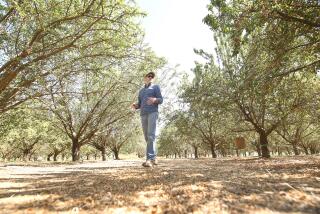Veterinary Researcher Follows West Nile Virus as the Crow Flies
The crisply dressed Air Force officer stops in mid-sentence to listen to the racket from the trees near the parking lot of the armed forces medical building.
“That’s juveniles talking,” he says. “It’s kind of a haw, haw, haw.” They’re still young, “just finding their way around, trying to keep a low profile.”
He is Lt. Col. Mike Bunning, and he is talking about crows. Loud, ill-mannered, hang-out-at-the-dump, eat-god-awful-anything crows.
As he stands between the old orange pickup truck he towed from Colorado and the recreational vehicle he lives in at the Ft. Detrick Army post in Frederick, Md., a look of endearment crosses his face.
In a way, they’re his crows.
And for the last year, he has camped out in this parking lot, raising eyebrows, reading Thoreau and trying to conquer the microbe that’s been killing them by the thousands: West Nile virus.
As the virus has spread this season, Bunning, with the help of others at the crack Army scientific installation, has been trying to see whether a new medicine that protects horses might also protect crows.
If so, he also wants to see if it might be effectively administered through bird feed.
That could be “huge,” Bunning said. If crows could be immunized in the wild via bird feed, the level of the virus in the environment might be substantially reduced, and thus the likelihood of human and animal infection.
“Controlling this disease in crows may control it everywhere,” he said.
Disease Cuts Cross-Country Swath
West Nile virus is carried mostly by crows and other birds and is spread through mosquito bites.
There’s been some urgency to the work this season, as the virus has spread dramatically, infecting birds, horses and a handful of people, from Canada to Key West, Fla., and from Washington to Chicago.
The virus, which was first seen in the United States in 1999, generally does not make humans sick, experts have said. It can cause mild flu-like symptoms in a few people. And in isolated cases, especially among elderly people weakened by other diseases, it can cause potentially fatal encephalitis, or swelling of the brain.
There have been about two dozen human cases this year--including nine announced in one week in Pennsylvania, Maryland and New Jersey--and one death.
Bunning, a trained veterinarian and infectious disease analyst attached to the federal Centers for Disease Control and Prevention, has waged his battle against the virus mostly in his spare time.
“I don’t have a life,” he said, laughing, as he sat in the RV one morning last month and explained his work.
Officially assigned to a military medical research center, Bunning, 47, has conducted experiments with the help of scientists and facilities of the Army and the aid of a state wildlife expert who captured crows for him at local dumps.
It has been demanding and, at times, bizarre work. Crows were captured, vaccinated, exposed to the virus and studied.
Scientist Works From RV Outpost
Two early discoveries were that Chee-tos and KFC chicken made the best crow bait, and the surest method of capture was a “rocket net,” in which a net is launched over the crows with rockets.
Bunning lived and often worked out of the RV, which is crammed with scientific papers, spray starch, cereal and a tiny TV set that gets one channel.
“It’s hot . . . in the summer and cold . . . in the winter,” he said as he sipped a diet soda at a tiny table cluttered with computer disks and salt and pepper shakers.
“It’s been an interesting year. I’ve dropped 30 pounds. I eat soup. . . . I run and eat.”
He said he chose the RV over an apartment to save money, after he and his wife decided that she and their three children would remain behind at their home in Colorado so their younger kids could stay in schools there.
He said the people at Ft. Detrick didn’t quite know what to make of him.
He was always looking for people to help with research on weekends. Often he had birds in the weathered wooden cage in the back of the pickup. And sometimes he would spread corn for the crows in the grass out back and sit outside at night in a beach chair.
Base officials “don’t really like that,” he said. “You can’t blame them. They don’t want to get something started, where everybody comes and lives in an RV. . . . So I don’t blame them. They’ve been kind enough to allow me a year here.”
When he travels off the base, he takes the RV. The pickup, a 1952 International with a cracked rear window, is too slow for the superhighway.
The work has been complex and serious. Bunning said the experiments seemed to prove that the vaccine would protect crows if given via injection, but it did not seem to protect crows who got it orally via bird feed.
Scientists are eager for an effective bird vaccine, in the hopes that it might be used to inoculate endangered species in zoos and nature preserves, if not immediately in the wild.
“The oral vaccine was a shot in the dark--very much on the edge,” Bunning said.
“But if the oral vaccine worked in crows, and if crows are a major component in the spread of West Nile, then what I would suggest is at this time of year . . . feed them at their roost,” he said. “If you could vaccinate them there, then the viral load in the environment goes down tremendously.”
Other West Nile vaccine research is underway. A British firm has announced that it has developed a human vaccine that it will start testing on people next year.
The U.S. Geological Survey is also working on a bird vaccine. And a horse vaccine got a conditional license from the Agriculture Department on Aug. 1. Fort Dodge Animal Health, the Overland Park, Kan., firm that makes it, sent 250,000 doses to veterinarians across the country last month, a company veterinarian said.
As for Bunning, even though the vaccine did not seem to work in the bird feed, he still believes the idea is solid.
“I don’t feel it’s a failure yet,” he said. “It may be that we don’t have the correct dosage.” He said he’d like to continue experimenting when he returns in a few weeks to the CDC branch in Colorado, where he will coordinate West Nile activities between the Pentagon and the CDC.
And when he departs, he’ll gather his books and research--he didn’t much care for Thoreau--hook the pickup to the RV and head west.
“I’ll carry forth,” he said, “wherever I’m allowed.”
More to Read
Sign up for Essential California
The most important California stories and recommendations in your inbox every morning.
You may occasionally receive promotional content from the Los Angeles Times.










